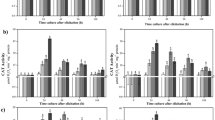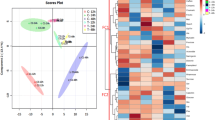Abstract
Cultured Cupressus lusitanica cells induced by various stresses are thought to produce different complexes of defense chemicals to optimize defense. To compare the induced products of two stimulations, we investigated the emission of monoterpenes, biosynthesis of β-thujaplicin, and accumulation of lignin in mechanically stressed and fungal elicited cultured C. lusitanica cells. Both mechanical stress and fungal elicitor caused emission of qualitatively similar monoterpene blends indicating de novo biosynthesis of these compounds after stimulation, while mechanical stress alone is sufficient to induce fungal elicitor-related monoterpene emission. Sabinene and limonene were the dominant compounds over the time course in both volatile blends. Although the emitted volatile blends were qualitatively similar, the time course and the relative ratios of the constituents of the volatile blends differed with the type of stimulation. While fungal elicited cells produced significant amounts of β-thujaplicin over the 5-day time course, no β-thujaplicin was observed in the mechanically stressed cells. The production of β-thujaplicin was the main dissimilarity of the induced products of these two treatments, suggesting that synthesis of β-thujaplicin is not a general response to all types of stresses, but is a specific response and serves as a strong toxic compound against already invaded fungus. Significantly higher amounts of lignin accumulations were observed in the fungal elicited and mechanically stressed cells on the 5th day after induction. Based on these results, we suggest the composition of induced products was dependent on the method of stimulation.






Similar content being viewed by others
Abbreviations
- SPME:
-
Solid phase microextraction
- FID:
-
Flame ionization detector
- GC/MS:
-
Gas chromatograph/mass spectrometer
References
Adams RP (2001) Identification of essential oil components by gas chromatography/quadrupole mass spectrometry. Allured, Carol Stream, IL
Aharoni A, Giri AP, Verstappen FWA, Bertea CM, Sevenier R, Sun Z, Jongsma MA, Schwab W, Bouwmeester HJ (2004) Gain and loss of fruit flavor compounds produced by wild and cultivated strawberry species. Plant Cell 16:3110–3131
Alborn HT, Turlings TCJ, Jones TH, Stenhagen G, Loughrin JH, Tumlinson JH (1997) An elicitor of plant volatiles from beet armyworm oral secretion. Science 276:945–949
Alonzo G, Saiano F, Tusa N, Fatta Del Bosco S (2001) Analysis of volatile compounds released from embryogenic cultures and somatic embryos of sweet oranges by head space SPME. Plant Cell Tissue Organ Cult 66:31–34
Bowles DJ (1990) Defense-related proteins in higher plants. Annu Rev Biochem 59:873–907
Campbell MM, Ellis BE (1992) Fungal elicitor-mediated responses in pine cell cultures-I. Induction of phenylpropanoid metabolism. Planta 186:409–417
Dicke M, Gols R, Ludeking D, Posthumus MA (1999) Jasmonic acid and herbivory differentially induce carnivore-attracting plant volatiles in lima bean plants. J Chem Ecol 25:1907–1922
Eckhardt U, Grimm B, Hörtensteiner S (2004) Recent advances in chlorophyll biosynthesis and breakdown in higher plants. Plant Mol Biol 56:1–14
Espinosa-García FJ, Langenheim JH (1991) Effects of sabinene and γ-terpinene from coastal redwood leaves acting singly or in mixtures on the growth of some of their fungus endophytes. Biochem Syst Ecol 19:643–650
Fujita K, Yamaguchi T, Itose R, Sakai K (2000) Biosynthetic pathway of β-thujaplicin in the Cupressus lusitanica cell culture. J Plant Physiol 156:462–467
Gamborg OL, Miller RA, Ojima K (1968) Nutrient requirements of suspension cultures of soybean root cells. Exp Cell Res 50:151–158
Hahlbrock K, Scheel D (1989) Physiology and molecular biology of phenylpropanoid metabolism. Annu Rev Plant Physiol Plant Mol Biol 40:347–369
Haluk J, Roussel C (2000) Characterization and origin of tropolones responsible for the Cupressales natural durability: potential application to wood preservation. Ann For Sci 57:819–829
Hano C, Addi M, Bensaddek L, Crônier D, Baltora-Rosset S, Doussot J, Maury S, Mesnard F, Chabbert B, Hawkins S, Lainé E, Lamblin F (2006) Differential accumulation of monolignol-derived compounds in elicited flax (Linum usitatissimum) cell suspension cultures. Planta 223:975–989
Hawkins S, Boudet A (2003) ‘Defence lignin’ and hydroxycinnamyl alcohol dehydrogenase activities in wounded Eucalyptus gunnii. Eur J Pathol 33:91–104
Huber DPW, Philippe RN, Godard KA, Sturrock RN, Bohlmann J (2005) Characterization of four terpene synthase cDNAs from methyl jasmonate-induced Douglas-fir, Pseudotsuga menziesii. Phytochemistry 66:1427–1439
Ibrahim MA, Oksanen EJ, Holopainen JK (2004) Effects of limonene on the growth and physiology of cabbage (Brassica oleracea L) and carrot (Daucus carota L) plants. J Sci Food Agric 84:1319–1326
Iiyama K, Wallis AFA (1988) An improved acetyl bromide procedure for determining lignin in woods and wood pulps. Wood Sci Technol 22:271–280
Inada S, Tsutsumi Y, Sakai K (1993) Elicitor of the β-thujaplicin accumulation in callus cultures of Cupressus lusitanica. J Fac Agric Kyushu Univ 38:119–126
Itose R, Sakai K (1997) Improved culture conditions for the production of β-thujaplicin by suspension cell cultures of Cupressus lusitanica. Plant Biotechnol 14:163–167
Keen NT (1992) The molecular biology of disease resistance. Plant Mol Biol 19:109–122
Koch G, Bauch J, Puls J, Schwab E (2000) Biological, chemical and mechanical characteristics of “Wulstholz” as a response to mechanical stress in living trees of Picea abies [L.] Karst. Holzforschung 54:137–143
Kordali S, Kesdek M, Cakir A (2007) Toxicity of monoterpenes against larvae and adults of Colorado potato beetle, Leptinotarsa decemlineata Say (Coleoptera: Chrysomelidae). Ind Crops Prod 26:278–297
Kuć J, Rush JS (1985) Phytoalexins. Arch Biochem Biophys 236:455–472
Lamb CJ (1994) Plant disease resistance genes in signal perception and transduction. Cell 76:419–422
Lange BM, Lapierre C, Sandermann Jnr H (1995) Elicitor-induced spruce stress lignin. Structural similarity to early developmental lignins. Plant Physiol 108:1277–1287
Lewis NG, Yamamoto E (1990) Lignin: occurrence, biogenesis and biodegradation. Annu Rev Plant Physiol Plant Mol Biol 41:455–496
Maes K, Debergh PC (2003) Volatiles emitted from in vitro grown tomato shoots during abiotic and biotic stress. Plant Cell Tissue Organ Cult 75:73–78
Maes K, Vercammen J, Pham-Tuan H, Sandra P, Debergh PC (2001) Critical aspects for the reliable headspace analysis of plants cultivated in vitro. Phytochem Anal 12:153–158
Mandal S, Mitra A (2007) Reinforcement of cell wall in roots of Lycopersicon esculentum through induction of phenolic compounds and lignin by elicitors. Physiol Mol Plant Pathol 71:201–209
Matsunaga Y, Fujita K, Yamada J, Ashitani T, Sakai K (2003) Monoterpenes produced by Cupressus lusitanica cultured cells including a novel monoterpene (1S, 2S, 6S)-(+)-1, 6-epoxy-4(8)-p-menthen-2-ol. Nat Prod Res 17:441–443
Miller B, Madilao LL, Ralph S, Bohlmann J (2005) Insect-induced conifer defense. White pine weevil and methyl jasmonate induce traumatic resinosis, de novo formed volatile emissions, and accumulation of terpenoid synthase and putative octadecanoid pathway transcripts in sitka spruce. Plant Physiol 137:369–382
Mitchell HJ, Hall SA, Stratford R, Hall JL, Barber MS (1999) Differential induction of cinnamyl alcohol dehydrogenase during defensive lignification in wheat (Triticum aestivum L.): characterisation of the major inducible form. Planta 208:31–37
Mithöfer A, Wanner G, Boland W (2005) Effects of feeding Spodoptera littoralis on lima bean leaves II. Continuous mechanical wounding resembling insect feeding is sufficient to elicit herbivory-related volatile emission. Plant Physiol 137:1160–1168
Morita Y, Matsumura E, Okabe T, Fukui T, Shibata M, Sugiura M, Ohe T, Tsujibo H, Ishida N, Inamori Y (2004) Biological activity of β-thujaplicin, the isomer of hinokitiol. Biol Pharm Bull 27:899–902
Mumm R, Posthumus MA, Dicke M (2008) Significance of terpenoids in induced indirect plant defence against herbivorous arthropods. Plant Cell Environ 31:575–585
Okabe T, Saito K, Otomo Y (1989) Antimicrobial activity and safety of hinokitiol. Fragr J 17:74–79
Predieri S, Rapparini F (2007) Terpene emission in tissue culture. Plant Cell Tissue Organ Cult 91:87–95
Reymond P, Weber H, Damond M, Farmer EE (2000) Differential gene expression in response to mechanical wounding and insect feeding in Arabidopsis. Plant Cell 12:707–719
Schmelz EA, Alborn HT, Tumlinson JH (2001) The influence of intact-plant and excised-leaf bioassay designs on volicitin-and jasmonic acid-induced sesquiterpene volatile release in Zea mays. Planta 214:171–179
Schmitt U, Singh A, Frankenstein C, Möller R (2006) Cell wall modifications in woody stems induced by mechanical stress. N Z J For Sci 36:72–86
Swain SM, Singh DP (2005) Tall tales from sly dwarves: novel functions of gibberellins in plant development. Trends Plant Sci 10:123–129
Timell TE (1973) Studies on opposite wood in conifers part I: chemical composition. Wood Sci Technol 7:1–5
Trust TJ, Coombs RW (1973) Antibacterial activity of β-thujaplicin. Can J Microbiol 19:1341–1347
Van Wijk M, De Bruijn PJA, Sabelis MW (2008) Predatory mite attraction to herbivore-induced plant odors is not a consequence of attraction to individual herbivore-induced plant volatiles. J Chem Ecol 34:791–803
Wu JY, Wong K, Ho KP, Zhou LG (2005) Enhancement of saponin production in Panax ginseng cell culture by osmotic stress and nutrient feeding. Enzyme Microb Technol 36:133–138
Yamaguchi T, Fujita K, Sakai K (1999) Biological activity of extracts from Cupressus lusitanica cell culture. J Wood Sci 45:170–173
Zabaras D, Spooner-Hart RN, Wyllie SG (2002) Effects of mechanical wounding on concentration and composition of essential oil from Melaleuca alternifolia leaves. Biochem Syst Ecol 30:399–412
Zhao J, Matsunaga Y, Fujita K, Sakai K (2006) Signal transduction and metabolic flux of β-thujaplicin and monoterpene biosynthesis in elicited Cupressus lusitanica cell cultures. Metab Eng 8:14–29
Author information
Authors and Affiliations
Corresponding author
Rights and permissions
About this article
Cite this article
De Alwis, R., Fujita, K., Ashitani, T. et al. Induced monoterpene and lignin production in mechanically stressed and fungal elicited cultured Cupressus lusitanica cells. Plant Biotechnol Rep 3, 57–65 (2009). https://doi.org/10.1007/s11816-008-0074-3
Received:
Accepted:
Published:
Issue Date:
DOI: https://doi.org/10.1007/s11816-008-0074-3




